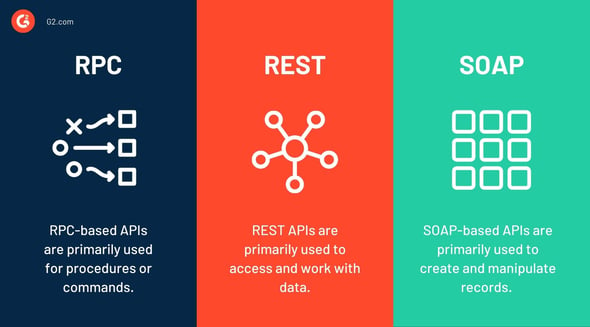
Technology and its space for innovative growth are infinite.
Software has dominated our lives with its presence felt in every single thing that we use, every place we go, and every decision we make.
Think of the innumerable software components we get to work with every day. Or the smart devices that modernized our living rooms. Or even how software has made your life easier by communicating your demands to devices in a language they understand.
To understand this communication process, we dive deep into the world of application programming interfaces (APIs) and how they revolutionized the world of web services.
Think of an API as a server at a restaurant who takes your orders and relays them to the chef, brings your order from the kitchen, and is also responsible for the indirect communication between you and the kitchen.
API management is defined as the process of managing application programming interfaces. APIs are responsible for creation, deployment, policy governance, and performance analysis.
An application programming interface (API) is an interface between various software components in a system. It defines the interactions that can take place between the components, the kind of requests that can be entertained, and the data formats that are acceptable. APIs mask the underlying code and make it easier for developers to use it by providing them with the functionalities they need.
With thousands of APIs in use by technology-backed businesses,
API management has gained prominence by offering a slew of useful functionalities that help companies manage their interlinked APIs better. With a projected growth of $6.81 billion by 2025, API management has risen as a leading software product category in the world of tech.
With a rapidly growing market for cloud-native microservices and mobile applications, APIs are a primary component of any technology-backed company’s software strategy. APIs can be majorly divided into three broad categories on basis of the functionalities they serve.

Remote procedure call (RPC) helps a computer program request and use a procedure located in a different computer and network without the need to explicitly code the interaction. An RPC protocol allows a client to execute a remote code on the server. RPC-based APIs are very tightly integrated, making it difficult for the developers to make any changes in them.
Representational state transfer (REST) protocol provides a communication channel to a distributed set of computers over HTTP requests. It follows an architectural style that involves various applications interacting over multiple web services. REST APIs need to be stateless (retain no data), have a uniform interface to work on, ensure the independence of client and server, and be loosely coupled for easy changes.
Simple object access protocol (SOAP) is helpful in the interaction between applications built on different operating systems and programming languages, via XML and HTTP. This web API protocol can handle stateful (requires data storage) operations without the need for extra code and has strong security measures in place.
API management tools streamline the API integration process and make it easier for the tech community to have centralized control over APIs. This is achieved through an intricate arrangement of components. These each have an important role to play in helping the API management system to carry out the tasks it was intended for.
Let’s take a look at the common components of API management tools.
An API gateway is responsible for receiving API requests, protocol translations, and communicating the backend services response back to the requester. A scalable API gateway is a critical component to ensure API performance is not affected as the business grows and more traffic is brought in.
An API developer portal is an essential knowledge-sharing portal where API documentation is accessible to the tech team. API documentation helps in streamlining the onboarding, building, testing, automating, and deployment process.
API management solutions are responsible for monitoring metrics such as API usage, runtime, availability, compute time, and performance. The real-time analytics reporting helps in troubleshooting glitches in the applications and provides a better insight to the developers.
API management software is responsible for API lifecycle management from the initial conception to building, testing, authenticating, automating, and integrating the API with the existing on-premises infrastructure. API lifecycle management is primarily responsible for a holistic view of the API creation to retirement process.
API management software can monetize commercial APIs and decide their pricing, usage, load, and functionalities. APIs are products that require heavy personalization to be used by any organization, so they need to be scalable and cost-effective. API management software provides multiple monetization options for any owned API depending on the functionalities provided.
API management holds the key to harness the full potential of the APIs available to an organization and helps them implement technology-driven decisions for the betterment of their business. Let’s discuss the primary benefits of API management.
API management tools have full control over the lifecycle of all the APIs used in an organization. Thus, their autonomy over the creation of APIs effectively reduces the time required to create new APIs in an iterative manner. They ensure the reusability of existing APIs by taking care of the operational policies, security compliance, and coding standards.
If your organization is reliant on legacy digital ecosystems, API management tools help you leverage their existing functionalities while giving them the advantage of having access to new APIs and SaaS-based platforms. This includes amalgamating your existing backend services into a single API and switching over to better security protocols over your existing code snippets.
Versioning of APIs refers to creating separate versions of the same API for different clients or business needs. API versioning is an important feature since it allows the developers to create and optimize multiple iterations of a working API suited to their own needs without touching the original API that may be in place for several important functionalities.
API management provides you with usage metrics, data analysis, and geographical usage statistics. These insights are valuable for organizations to make data-driven decisions for better digital transformation results.
Operational metrics indicate the stability of an API platform to help identify the ones that need to be retained or optimized. Business metrics comment on the performance of APIs over the business value or revenue generated from a particular API.
API management software ensures uninterrupted access to your business APIs and also takes proactive care of the issues that may be encountered by users on a regular basis. This includes reducing the hassle of configuration management for the developers and making cross-project collaborations easier for non-technical shareholders.
Business-specific needs for wash projects keep updating, meaning API management tools also ensure that extendible open-source plugins needed to support existing API programs are integrated with no hassle when needed.
A plugin is an additional component added to existing software to provide it with a bit more functionality than the original. With the advent of serverless and cloud-native architecture, customized plugin support has become a necessity to keep up with the ever-changing project workflows.
With billions of dollars being invested globally in API management software, it is imperative to have set parameters to evaluate their performance. Organizations need to judge them on a timely basis in order to understand what is working for them and what more can they get out of the software.
Here are the five most important KPIs for any API management tool.
An API management tool’s dependability can be assessed by uptime metrics, API traffic, and its ability to handle its assigned quota of requests. End-users have a self-service option to take care of known issues without any developer intervention.
When adopting APIs, developers need to have ample options available with them with regards to the functionalities, so that they can use them as needed. This is an important KPI since APIs are often used in multiple projects and having multiple functionalities helps brand them more critical to the company.
The quality of an API management tool is assessed by comparing the day-to-day performance of it with respect to the functionalities promised. An API management tool should be able to manage tasks that were marketed as their functionality on a regular basis.
API management tools need to demonstrate speed in areas such as accessing the proper APIs as needed and the volume of requests processed in a particular interval. These metrics are critical for business continuity.
Monetary value is obviously an important parameter to consider since no business likes to lose money on an obsolete tool. API management platforms need to ensure their customers are getting the quality of work that is expected for making an investment in them.
With a rise in the number of API management tools, it can be difficult to choose the right one for your business. Luckily we’ve rounded up the top five solutions to help you make a decision.
API management software is responsible for full API lifecycle management of business application program interfaces and assisting in the API design, monitoring, analyzing, and reporting of performance.
To qualify for inclusion as a top API management software, software must:
*Below are the five leading API management solution providers from G2's Winter 2021 Grid® Report. Some reviews may be edited for clarity.
MuleSoft Anypoint Platform is a hybrid integrated platform that takes care of applications, data, and devices both on-premises and over the cloud. It's also responsible for managing a common solution for iPaaS, ESB, and API management systems.
“I like that it has several functionalities that enable us to build a better work environment, particularly one of its critical characteristics, which lets us create a system of connections between many systems of our business, with more than 100 connector choices.”
- MuleSoft Anypoint Platform Review, Traci R.
“Your user cannot be reused. Every time you have a new company project on Anypoint Platform, you need to create a new user and associate it with the new company. There is no way to have a single user and administrate the access or the projects.”
- MuleSoft Anypoint Platform Review, Guilherme T.
Postman is a collaborative platform for API management with multiple features designed to make API creation easier and faster.
“You don't really need to be a programmer or a Computer Science major to understand how to develop a test for an API with Postman in sharp contrast with doing that by a normal text editor or by CLI, it makes it approachable to understand each of the values and parameters in an API. If you know what you are doing it can cut your time trying to write tests and executing them in half.”
- Postman Review, Shakil B.
“I feel there is a need for some open-source Postman collation repository for all open source APIs available at a click from within the app. Because this is something all the developers will love to have. Webhook endpoints for all common open source APIs will also be very appreciated.”
- Postman Review, Kumar P.
Looking for tools that deliver better than Postman? Explore our 2025 guide to the best Postman alternatives.
AWS CloudTrail is responsible for managing an organization’s AWS activity trail and troubleshooting issues that may occur in your various applications.
“CloudTrail helps to troubleshoot a lot of permission-related issues in AWS. Also, CloudTrail can be enabled in the Master Organization account. No need to enable it in each and every child accounts.”
- AWS CloudTrail Review, Manoj K.
“The tool can be made easier to read and use because it takes some time to understand how it works. A lot of people don't even know that this tool exists.”
- AWS CloudTrail Review, Abhishek A.
SAP Cloud Platform or SAP Integration Suite helps create and manage new applications in a SAP cloud computing environment. It acts as an open PaaS, connecting both on-premises and cloud infrastructure.
“The SAP Cloud Platform (SCP) has an exceptional availability of the services. SCP has amazing security and updates which leaves us as the developers focusing on the more important stuff. Integration with the system is flawless, and when things go wrong, there are logs that provide the details as to where things went wrong.”
- SAP Cloud Platform Review, Andrez Z.
“SAP Cloud platform is restricted for non SAP use cases. Neo is still used which is too old. Cloud foundry is better now. I recommend the Cloud platform only to leverage the existing business content available on SAP CP such as deploying.”
- SAP Cloud Platform Review, Vyas S.
Dell Boomi is a scalable platform that unites your applications and documentations in an accessible manner for the whole organization.
“It is really simple to use the no-code flowchart canvas to imagine the workflow. There are a lot of built-in custom connectors that make it simple to create integrations. This product's ROI is outstanding. Without the need for deep technological expertise, basic integrations can be quite easily created. For more simple integrations, method diagrams are easy to read and understand. There is a plethora of knowledge in process papers, but what you are searching for can be difficult to locate.”
-Dell Boomi Review, Garnette L.
“May need some time to train and there is some learning curve however extensive training material is available for this online”
- Dell Boom Review, Robert I.
API management is indubitably a significant process organizations are adopting for the benefit it provides to every aspect of their business be it monetary or productivity. Handling multiple APIs can be cumbersome for developers, and taking advantage of API integrations can be a task for non-technical people in the business.
API management tools not only take care of the existing APIs and providers, but also equip an organization to smoothly onboard new ones by providing a knowledge base of inter API functionalities accessible to everyone.
Organizations can reap the benefits of API management through proper user provisioning and ensure that every functionality is being utilized to its full potential.
Dibyani is a former Content Marketing Specialist at G2. In her free time, you can find her scribbling fanfiction and brushing up her knowledge on various fandoms (Harry Potter, mostly).
Finding effective ways to communicate can be a real challenge, especially when teams span...
 by Holly Landis
by Holly Landis
I’ve always loved to travel.
.png) by Tanuja Bahirat
by Tanuja Bahirat
As a marketer, I work extensively with multiple cloud-native applications, and my workflow...
.png) by Shreya Mattoo
by Shreya Mattoo
Finding effective ways to communicate can be a real challenge, especially when teams span...
 by Holly Landis
by Holly Landis
I’ve always loved to travel.
.png) by Tanuja Bahirat
by Tanuja Bahirat


